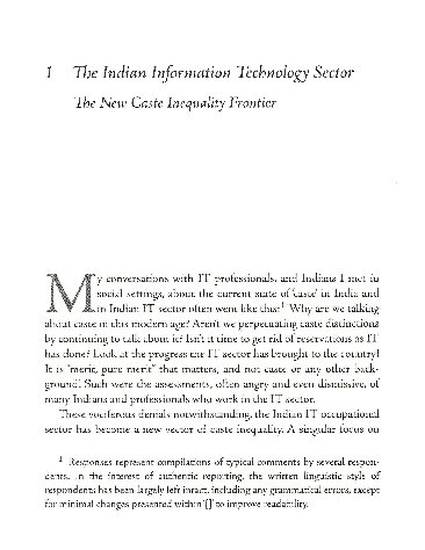
My conversations with IT professionals, and Indians I met in social settings, about the current state of 'caste' in India and in Indian IT sector often went like this:1 'Why are we talking about caste in this modern age? Aren't we perpetuating caste distinctions by continuing to talk about it? Isn't it time to get rid of reservations as IT has done? Look at the progress the IT sector has brought to the country! It is "merit, pure merit" that matters, and not caste or any other background'. Such were the assessments, often angry and even dismissive, of many Indians and professionals who work in the IT sector.
"These vociferous denials notwithstanding, the Indian IT occupational sector has become a new vector of caste inequality. A singular focus on 'Merit, Pure Merit; assiduously honed in ideology and in practice, has ironically become responsible for reproducing caste structures in IT. How is this merit constructed and practiced in the IT sector:' And how does caste factor into, even if implicitly, the merit constructions? Theoretically guided empirical answers to this set of questions are offered to clarify the broad assertion that Indian IT is the new caste inequality vector.
Pure merit in the Indian IT world, simply put, refers to technical skills and qualifications that are earned through a much heralded Horatio Alger model of personal aspiration, initiative, and hard work. It is the opposite of caste-reservation or caste-earmarked2 merit-merit acquired through the constitutionally mandated caste-based social redress and justice programs, popularly referred to as reservation and affirmative action.3 These programs were designed to reduce, and even to eliminate, the vestiges of centuries-long caste-based inequalities. But, how pure is 'pure merit' after all:' Because, often left unspoken and not examined in the valorized abstract IT merit discourse is, the 'symbolic4 merit' -the fact that the cultivation and practice of pure-merit is deeply embedded in, supported by, and 'hidden' behind the social and material privileges of the dominant castes and middle classes. In this sense, symbolically embedded merit is, ironically, not that different after all from reservation merit. But, unlike symbolic merit, reservation or earmarked-merit is foregrounded on minority caste status and authorized by the government, but not culturally accepted in the broader societal context.

Copyright © 2018. Reproduced by permission of Oxford University Press. This material was originally published in The New Frontier: Merit Vs. Caste in the Indian IT Sector by Marilyn Fernandez, and has been reproduced by permission of Oxford University Press. For permission to reuse this material, please visit http://www.oup.co.uk/academic/rights/permissions.